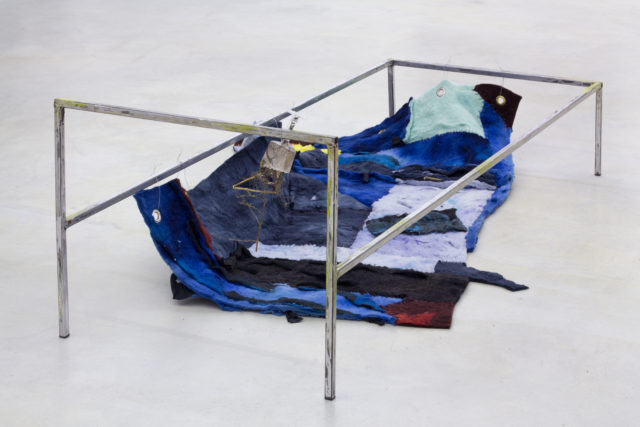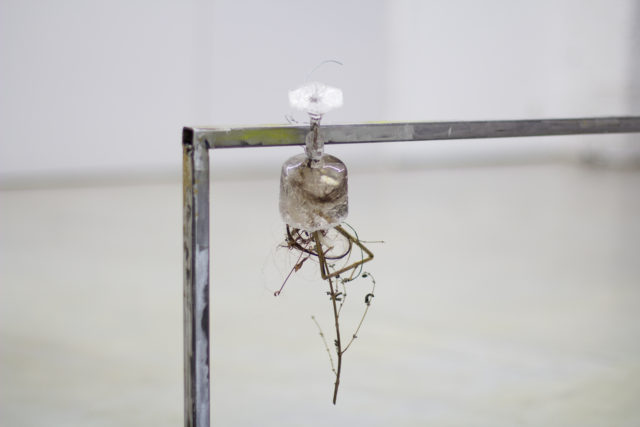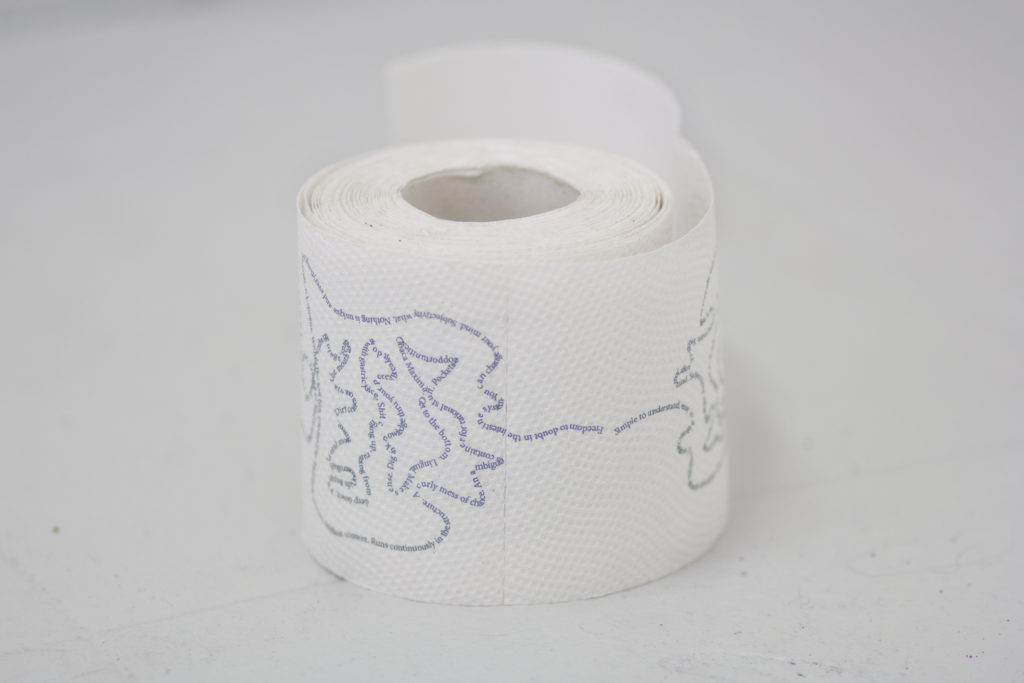Inger Wold Lund is a writer who uses both written format and oral narration, often told in the form of short stories, written in both English and Norwegian. Recent books include ‘Leaving Leaving Behind Behind‘ (2015) published by Ugly Duckling Presse and ‘Ingenting skjedde‘ (2015) published by Flamme Forlag.
Camilla Steinum is a Berlin-based artist making large sculptures in a variety of materials. She has a background in textiles, and uses her knowledge of fabrics to explore relationships between subjects like the inside vs. the outside and clean vs. dirty.

I met up with Camilla Steinum to interview her on the occasion of her upcoming exhibition In Spite of Chores, opening February 11 at Berlin’s Soy Capitán. It was a Saturday night in Oslo, the city Camilla grew up in; a city where I have recently tried to establish a home. While other people were in their living rooms watching Netflix, or drinking in the many bars of the city, Camilla was in her studio at Oslo’s National Academy of the Arts where she has been invited to be a guest artist. Working.
Camilla and I studied together. Later we went on to share an apartment in Berlin for some years. I know her habits. I was not surprised to find her working on a weekend. Of the artists I know, she is one of the most active, not because of a tormenting work ethic, but rather a curiosity with what her sculptures will end up becoming.
She met me at the main entrance of the studio. The lights were on, but there was no one else there. We took an elevator to the textile department. Camilla showed me her newest work, gave me advice on my problems, asked me what I thought of the dark-blue sweater she had bought earlier in the day at the January sale, made some coffee and worried about spilling some on her new jumper, all before we sat down in her office and I turned on the recorder.
Inger Wold Lund: Shit.
I said.
IWL: Let’s start this by talking about shit.
Camilla Steinum: It is such a large topic. I get both excited and overwhelmed just thinking about it. I do not know if one can even cover the most important aspects of it in a short interview. I mean, there is physical shit, but then there is also the metaphorical shit. I think both the physical and the metaphorical is important. I am also interested in any combination of the two. In terms of metaphors, one often elevates language to something clean. Language is somehow a place where one tries to explain something in a very clear way — making it also a place of power. In some way working with materials is the opposite.
I think that my reaction towards shit is stronger than that of many other people, like hair between my toes when I shower in a public pool. Those things give me the creeps. When I exhibited soaps in one of the showers at the artist house Kule as part of my exhibition Ambiguous Container for Rational Stuff (2015), an artist living there sent me a message asking ‘Are the soaps made of organic materials?.’ He had been using the soap that I had stuffed with other people’s hair, cigarette butts… and to me…
Camilla pauses. She does not say any words but it clear what she is thinking. Then she smiles, and finishes the sentence.

Photo: Paul Barsch. Courtesy the artist.
CS: …well, it makes me very happy.
The artist’s fascination with the bathroom goes back to when she was a child. The middle one of five siblings, Camilla always shared a room, and the bathroom was the only place where she could lock the door and be alone. The special role given the lavatory, not only as a place of privacy, but also as a place where shit exits the body, is washed off the body, and again enters into a wider circulation with the outside world, is something that she has researched artistically. Camilla has, in the recent years, not only made the large textile sculptures she is most known for, but also made work in the shape of toilet rinsers and toilet paper, in addition to the mentioned soaps.
CS: When I started working with textiles, I was focused on weaving. For me, that was about forcing shit into the structures. Trying to break the structure of the machinery. The threads that are always so stringent. Recently, I have started felting, and that is in many ways the opposite.
IWL: You have been on a long break from weaving?
CS: Yes. Partially because I have not had the space for it in my Berlin studio. Now, while a guest here, I have the possibility again, so I have picked it up. And then I thought it would be interesting to combine the techniques. In some ways I think it would be interesting to combine everything that I have ever done. Even the still lifes did that one year.
Camilla is talking about 2012; a year she spent making small oil paintings of objects like her sunglasses, a towel from Missoni, a running shoe and other things she had lying around in her home.
IWL: Weaving has had some sort of a renaissance. From being associated with women, arts and crafts, and being an underdog compared to the fine arts, it is now included in major exhibitions. In some ways felting is still an underdog?
CS: The reason I started felting was in some ways to stop working against the structure. There is something very uncontrollable when working with felt. Deleuze and Guattari talk about the hierarchical structure of weaving in opposition to the nomadic structure of felting in a text from The Thousand of Plateaus. Felting is nomadic, in that it spreads. The same goes for plaid work. When I started cutting up my work and patching it back together, it was really in the nomadic way of working. But also, I like the way felting is so strongly connected to the idea of a hobby. When I searched Youtube for how to do it, I saw women, mainly women, making tiny flowers with wool in-between bubblewrap, like this…

Photo: Paul Barsch. Courtesy the artist.
Camilla moves her hands in tiny movements, imitating the sound that it makes. A high-pitched noise.
CS: I enlarged the process, put in all sorts of other stuff, and rolled the gigantic fabrics on the dirty studio floor. I liked it. At the same time I was also making nets. And you can look up videos of that, as well on Youtube, but then all you will see are these macho men out in the woods learning how to tie nets for fishing. In some ways the process is the same, it is all crafts, but the approaches are widely different.
Camilla asks me if we can talk more about shit, and I say anytime, but ask a different question instead.
IWL: The way I see it, your own method is, in many ways, to do things in the most difficult. You make your own textiles, weaving tiny objects into them, where sowing them on would have looked almost the same but with way less work. Then you color them, often multiple times. You build your own structures to hang them on, with materials that you also re-work. You put time into things that in many ways are important, but that many people will not notice. What are your thoughts on that?
CS: In some ways I see myself as lazy, and I wish to do things quickly, so it is a bit of a paradox. It is not that I am extremely detailed, I really do not know how I always end up doing things in the most difficult way, and the most expensive one. Like, when I was making some tables for an exhibition at the Munch Museum here in Oslo, and I bought metal, but ended up buying stainless steel, which is not only hard to work with but also really expensive. Then I welded it together, painted it, removed the paint, and it ended up looking like something I had found on the street. Why could I not just have bought the cheapest steel? Or actually found something on the street? But, in some way, I think everything needs to go through a process where I work through all the material. Even found objects need to be worked on. In some ways I like doing things that feel 100 per cent absurd, because so much of life is absurd. To give an example, I like that feeling I get when I am in the workshop cutting up knives and coins.

Photo Damian Griffiths . Courtesy the artist.
IWL: Which is also illegal?
CS: I have tried researching that, but found no clear answer. What I found, though, was the fact that by taking money out of circulation, the remaining money increases its value. I find that interesting. In Michael Haneke’s film Der Siebente Kontinent they flush money down the toilet. A lot of other really disturbing things happen in that movie, as well, but what provokes people watching it the most is the destruction of the money. Here in Oslo there is a man hammering coins flat that I am somewhat a fan of. He lives on the street and spends his time taking coins out of circulation in his very own way.
IWL: You say that you see yourself as lazy, but you are the person I know that finds the most comfort in being in your studio and working on sculptures that you almost do not really care if other people see.
CS: I am really happy when people want to show my work. But I do think, and this might be a strange thing to say in an interview that is being published, that one of the things that sucks about being an artist is that what you do is public. But one has to show one’s work. I will say though, that what I enjoy the most is the process of creation, making things up, combing through them and installing them, and then to see how it turns out. I think I am very curious, and I think that is the main reason I can sometimes work so much. I am curious how the work I am doing now will end up looking, and I turn impatient. I notice the same thing when I meet my brother’s kids. It will take so long before they are an adult. They are somehow not finished yet. Yes, they are shit cute, but I have to wait 18 years or so before they are fully developed human beings. Seeing them, I realized that this is the sort of impatience I have with my work. Luckily, I have more to say when it comes to how fast I finish my work.
IWL: It is a funky combination to be that impatient and then weaving tiny skulls you have bought in the hobby store into your fabric.
CS: I like the idea of putting a lot of work into something that gives very little result.
IWL: It is a bit anarchistic.
CS: I hope so.

Photo Øystein Thorvaldsen. Courtesy the artist.
We go on talking about Nietzsche; his collected work takes up a big chunk of Camilla’s bookshelf, days spent reading him, and then not reading him, days when one can look past aspects of his writing, and days when the shit he throws women is just too much. We talk about control, and lack of control. We talk about trailers and collaborations. And then we return to shit.
CS: Some sculptures I was supposed to exhibit this summer were eaten by moths. And then I just had it! One can get enough of shit! There was the thought of accepting it all, and bringing it in. And there was the thought of it being a good thing to let the work move back into the circulation of nature. In some ways I found it nice that the moths could have a mega feast in my work. But after freezing the work to get rid of the moths there was really nothing left but dust.
I turn off the recorder.
Camilla wonders whether she should go on working. It is closing in on midnight. We decide to head to her father’s garden cottage where she is staying during her time in Oslo and drink some wine instead. I sleep over in her younger brothers room. The room used to be hers, and warning signs that she cut off packages of cigarettes are stuck with thumbtacks to one of the shelves. They are telling you about the shit that will happen if you let shit go the wrong places.**













